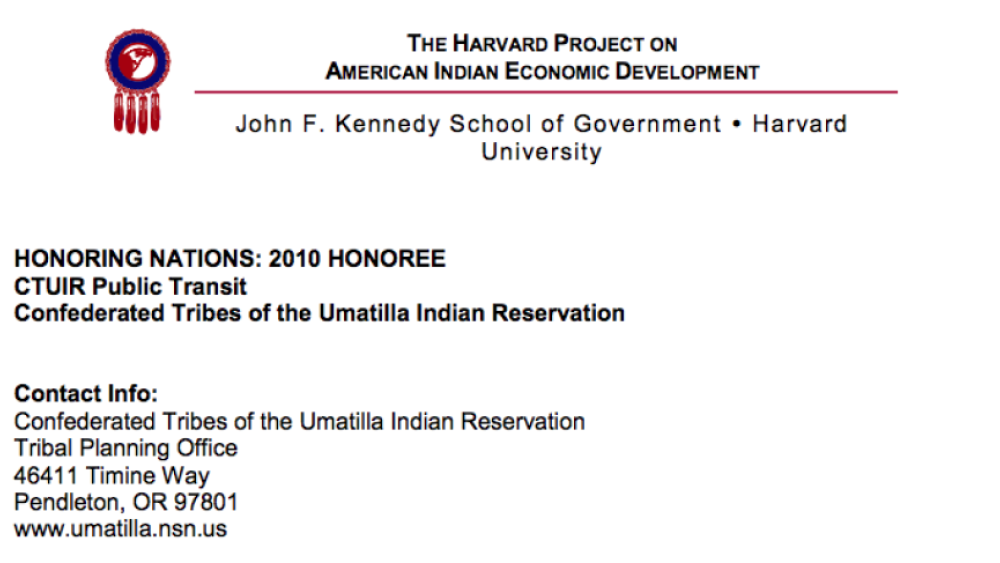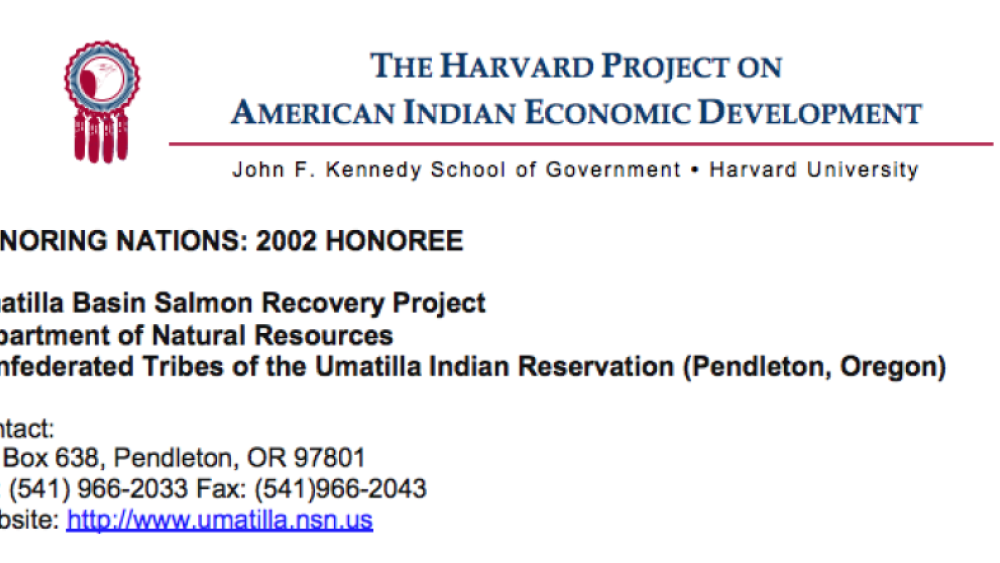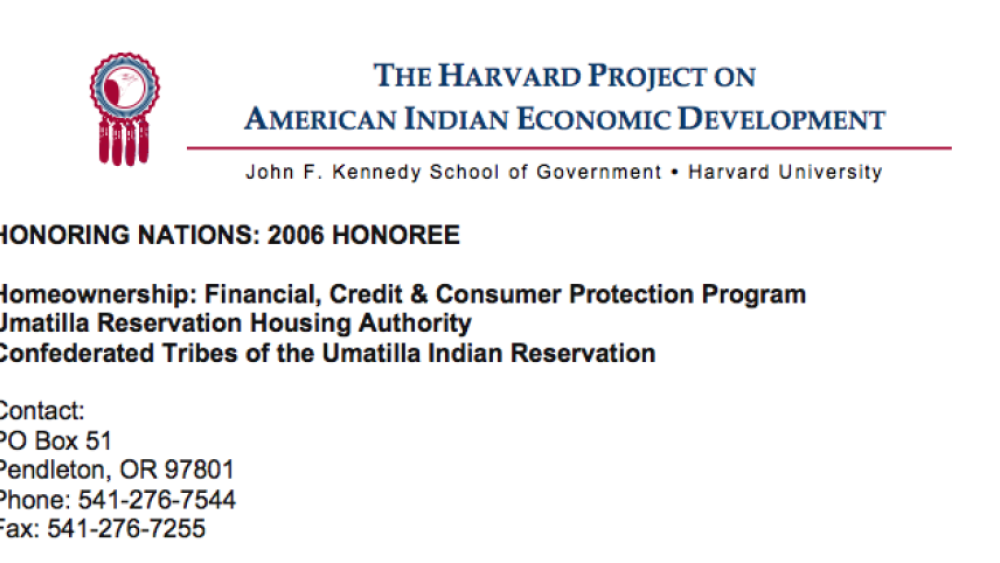This video, produced by the Confederated Tribes of the Umatilla Indian Reservation, explains the process by which a public transit program was implemented for the benefit of tribal members and, eventually, non-tribal members in neighboring communities.
Additional Information
CTUIR Tribal Planning Office. "Confederated Tribes of the Umatilla Indian Reservation Tribal Planning Office Public Transit Program." Dir. Alfred Diaz. Ad Video Production. Pendleton, Oregon. October 2011. Film.
This Honoring Nations "Lessons in Nation Building" video is featured on the Indigenous Governance Database with the permission of the Harvard Project on American Indian Economic Development.
Transcript
[Harmonica]
Narrator:
“There was a time when the Cayuse, Umatilla and Walla Walla Indians roamed an area as large as 6.4 million acres. Their territories ranged roughly from the communities of Joseph, Oregon to the east and The Dalles, Oregon and Yakima, Washington 200 miles to the west. Today, in comparison, the reservation lands of the Confederated Tribes of the Umatilla Indian Reservation are a mere fraction of the area once traveled by tribal members, a total of 175,000 acres. Since the creation of the reservation system, inter-regional travel for subsistence, jobs and cultural enrichment has been fraught with struggle for tribal members that live both here and in the nearby communities. Within the last decade, the Confederated Tribes have made great advancements to bring mobility back to their people and to non-Natives living in neighboring communities, so that once again the Cayuse, Umatilla and Walla Walla Indian nation are greatly embarking on interregional journeys through their ancestral lands.”
Jim Beard:
“CTUIR Public Transit is an integral part of the tribe’s overall economic development program. It’s not only a recruitment tool, but it also optimizes their investment in job creation by improving access to the workplace. Public transportation connecting rural northeastern Oregon and southeastern Washington would not be here today or 20 years from now if not for the Umatilla Tribes. For thousands of years, the tribes have travelled the routes and stayed at the places in their homeland that now make up the tribe’s regional transit service area. But most importantly, because of sovereignty and self-governance, the tribes have transcended political and jurisdictional boundaries to provide essential services where state and local governments have neither the sense of responsibility, understand the value to regional economic development, or possess the authority to serve in this regional context.”
Narrator:
“In the early history of reservation life, inter-regional travel was not only uncommon, but required permission from the federal government. Civil rights advancements would later establish full citizenship for Native Americans, thus allowing them the right to move about freely. The latter half of the 21st century saw other advancements in civil rights and self-governance. But up until the turn of the century, tribal members for the most part were still economically constrained to the reservation because many lacked the one vehicle that most Americans had come to rely upon for their inter-regional travel.”
Susie Calhoun:
“Transportation has always been either you walk or you have a car in this area. So the issues of transportation were just that. You either knew someone that had a car, you had a car, or you walked everywhere you went.”
Narrator:
“Post-World War II America saw a boom in modernization and along with it a growing dependence on the automobile and the network of highways and interstates. Without the economic ability to purchase and maintain vehicles or even a driver’s license, tribal members were literally left stranded on the roadside usually having to walk the five miles into town along the dangerous shoulders of the highway.”
Susan Johnson:
“They didn’t have any transportation at all. You would see people walking on the road continually between Pendleton and Mission.”
Narrator:
“In the nearby town of Pendleton five miles away, public transportation was almost nonexistent and limited to city boundaries so that by the end of the 21st century the city of Pendleton’s transit service had failed to reach the population of 3,000 living five miles away on the Umatilla Indian Reservation.”
Susie Calhoun:
“People would walk to town to get groceries, they’d walk to town to drink. Alcoholism is big. You’d see people just passed out on the road or on the side of the road and it was dangerous.”
Narrator:
“As the rights of self-governance increased, so did the ability for tribal leaders to implement programs and develop solutions to the socio-economic challenges their people faced. Better health care, better schools, and eventually stable employment, but access to these facilities was still difficult because of lack of transportation to meet all needs. It was a drive to increase employment on the reservation that would eventually lead to improvements in transportation. In 1994, construction of the first phase of the Wild Horse Resort and Casino was completed, instantly creating not just a steady workforce on the reservation but a growing workforce.”
Lorena Thompson:
“We’ve gone through four expansions from the initial 80 that we hired just with our temporary facility and it was more training until when we opened the resort where it is now where we employed 300. Then we went through another expansion adding all of the administrative. Then we did a consolidation with the hotel, the RV, golf course and Tamástslikt Cultural Institute.”
Narrator:
“Over the next few years, the workforce at the resort would grow three times what it was in 1994. Today, the reservation’s combined employers made up of the Wildhorse Resort, Tamástslikt Museum, Tribal Governance Center, Arrowhead Travel Plaza and Cayuse Technologies have made the Umatilla Indian Reservation the largest employer in eastern Oregon. Tribal government employs close to 600, Cayuse Technologies another 200, combined with Wildhorse Resort employee base for a total of 1,500 tribal and non-tribal employees. But workers require transportation, especially the service-sector workers who cannot often afford personal vehicles to travel the great distances common in rural areas.”
Lorena Thompson:
“We did find that being on schedules 24/7, having different schedules we had difficulties with employees getting here.”
Narrator:
“With a growing demand for a stable employee base, the Board of Trustees understood that it would benefit the tribes to have transportation service to the entire region. As a sovereign nation, the tribe’s recognized the value of extending their interest by providing transit services to lands beyond their reservation boundaries and this transit service would be free to all people living within their original homelands. In October of 2001, a passenger bus was borrowed from the city of Pendleton to begin a free bus service between both communities.”
Jim Beard:
“After a while, we were putting so many miles on it that they said, 'Ah, you better get your own bus.' So we went out in 2002 and bought our first bus and we ran that for several years just between Pendleton and Mission, the five miles between the two communities here. And then we began to see that there were a number of people who are employees here that live in these surrounding little communities and so we decided the next thing to do would be to go out to these areas.”
Narrator:
“Private taxis also provided services during odd hours when the transit wasn’t running or for tribal members who preferred a less public mode of transportation. The initial fee for senior tribal members to travel between the reservation and Pendleton was $1 each way. Taxi vouchers are still provided for tribal members, with the Tribes paying the remainder of the cost. As for the Confederated Tribes Transit Service, it was and still is free to all people using it to travel their ancestral lands.”
Jim Beard:
“Collecting fees won’t make or break this system. It’s a nuisance to collect the money, it’s just one more administrative function that we would have that we’d just as soon not, and besides it provides a lot of good will to the communities around here and to the people that the tribes are willing to provide this service to them for free.”
Narrator:
“Since the initiation of the bus and taxi programs in 2001, both have seen tremendous growth, with the free transit line experiencing the greatest increase with just under 5,000 riders in its first year of operation to nearly 60,000 riders in 2010. With such growing demand, the Board of Trustees recognized the value of expanding the transit system beyond the scope of getting workers to a job site. Over the next several years additional city runs would be added to increase services to all people with a variety of destinations and purposes. The communities of La Grande, Stanfield, Echo, Hermiston, Athena, Milton Freewater, Pilot Rock, and Walla Walla and Tri Cities in Washington were added, once again available to both tribal and non-tribal members with no rider fee to help people achieve inter-regional travel on their ancestral land.
Today, the Umatilla Reservation funds and operates seven free transit lines that help riders travel to facilities on and off the reservation as well as helping travelers connect with other communities and other transportation in the Northwest. On the reservation, regular stops are made at governance centers, medical facilities and the Wildhorse Resort and Casino. Additional stops are made along the way when requested. Off the reservation, transit buses will stop at city centers, airports, bus stations and other key locations that will provide the greatest accessibility for the rural residents of Umatilla County. The Mission run to Pendleton is still the most widely ridden but other runs are growing in significance such as the Walla Walla Whistler run, which connects to the nationally acclaimed Wine Country 40 minutes to the north which has a regional population of 45,000.
While many rural transit systems target senior and disabled populations tribal planners recognized the primary focus of its services needed to be centered on getting employees of tribal enterprises to the job site and enhancing the tribe’s economic development initiatives. By far the most common destination for riders has been traveling to and from work. According to a recent study of the 1460 people employed by the Confederated Tribes of the Umatilla Indian Reservation, 55 percent were non-Indian while 33 percent were tribal members, and another 12 percent were members of other sovereign nations.”
Susie Calhoun:
“So it’s made people very, very self sufficient. They can go to work, they can get there, they can get back, it’s all on their own and it’s really a positive piece in people’s lives.”
Lorena Thompson:
“Making it easier on our employees to take care of their personal needs, to get to work which is their personal responsibility, but having that transportation opportunity is just great, it’s a great advantage for them and for us as the employer 'cause we know they will be there.”
Narrator:
“It is a system open to all, free to all and in some cases the benefactors go beyond people to the very creatures of this land of whom we are charged to be their stewards.”
Lynn Tompkins:
“Usually, the bus drivers in fact are just kind of excited about the birds on the bus and what do you have today and kind of thing, so we’re very appreciative of the tribe’s willingness to transport. Blue Mountain Wildlife is a wildlife rehabilitation center. The tribal bus service helps us hugely with transportation cost and time. When we’re really busy, we will often meet two buses a day. Being able to release a bird is always the best part. So when we get to release a bird, it’s just a really great feeling and if that means saying goodbye on the bus, that’s okay.”
Narrator:
“So as it was more than 150 years ago when the Cayuse, Umatilla and Walla Wallas roamed their vast ancestral lands, once again the first people of this land are able to roam and travel using a network of public transportation systems that follow their traditional routes.”
[Singing]
Ya’ll come with us and ride the bus, we’ve made it easy, there ain’t no fuss. Catch a ride into town, stop and shop and you’re homeward bound. If your wheels are down and you’ve got no ride, we’ll get you to work even on time and the price is right if you like it free, four trips a day, six days a week."
Susan Johnson:
“That was Harpman Beard for the Confederated Tribes Bus Service and I am Susan Johnson, Bus System Manager. So get your schedule at the planning office and take advantage of this wonderful offer.”



